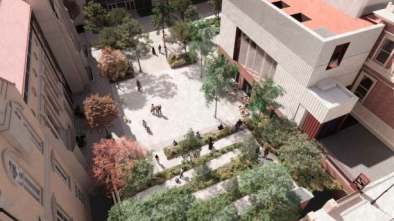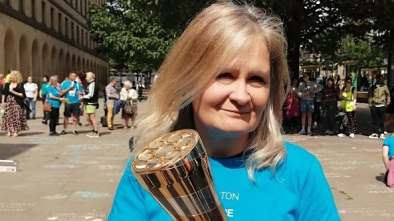The Lydgate War Heroes Who Died At Gallipoli
Residents of Lydgate are researching the lives of 50 fallen First World War heroes, who are remembered at St Anne’s Church in the village.
The church memorial includes 44 names of local men who were killed in action, and a further six soldiers are buried in the churchyard. Most are from Lydgate, Grasscroft or Springhead, with a few from further afield who had connections to the church.
Members of the Love Lydgate group are planning to remember the men at a service on Armistice Day next month.
Jennifer Greenwood from Love Lydgate said: “The remembrance service is what we’re working towards. I’m hoping it’ll be quite a big thing and that young people will be involved.”
Local man Andrew Heathcote has been leading the effort to find out more about the men, and his research has already turned up some fascinating and tragic stories.
Andrew said: “I’m just trying to put faces to the names. We’re going to do a display in the hall on the 11th. History’s always fascinated me, but the local connection has made it even more interesting.”
He’s keen to hear from anyone who might have information about any of the fallen heroes, and asks that anyone who knows anything contact him by e-mail at this address: lydgate1914-18@hotmail.co.uk
One of the most sobering of the stories Andrew has researched is that of the Clegg brothers, John and James. Sons of John and Alice of Hill Top House in Lydgate, the brothers were killed just over a week apart in May and June 1915 while fighting in the Gallipoli Campaign in modern-day Turkey.
The younger brother, James, was killed while fighting with the Manchester Regiment on 25 May. An engineer machine fitter, the Lydgate parish magazine of that July recalls that the Lieutenant was known as “Gentleman Jim” and served as a church officer at St Anne’s.
Its tribute to him concluded: “A bright, helpful and hopeful life has been cut short, but ‘he did what he could’ his duty to God and his neighbour and he died a brave man.”
It soon proved to be a double tragedy for the Clegg family, as John, the eldest of five siblings, died on 4 June. A solicitor and former Secretary of Diggle Rifle Club, he had also seen action during the Boer War of 1899-1902, and had risen to the rank of Sergeant in the Manchester Regiment by the time of his death.
The August parish magazine lamented: “We are most unwilling to write anything that will harrow the feelings of those thus bereaved, but we cannot refrain from expressing the widespread and intense sympathy that was felt for Mrs Clegg and her family when it became known that Sergeant John Clegg had been killed in action in June.”
The Gallipoli campaign is often associated with Australia and New Zealand because of the relatively large number of soldiers from those countries who perished. But it was just as deadly for both the British and French allies on one side, and the Turkish Ottoman forces on the other, with each army suffering high casualty rates during fighting which lasted for most of 1915.
The date of John Clegg’s death, 4 June, is particularly significant. That was the day of fierce fighting in what became known as the Third Battle of Krithia, a defeat for the British and French in which the British alone suffered an estimated 4,500 casualties as they attempted to advance on Ottoman defences. It appears likely that Sergeant Clegg was one of those.
The British and their allies had begun the Gallipoli campaign in April 1915 with the goal of capturing the Ottoman capital of Constantinople, better known today as Istanbul. But it ended in a humiliating retreat in January 1916.
Both the Cleggs are remembered on the Helles War Memorial in Turkey. The Cleggs are just one of six sets of brothers on the Lydgate memorial, while a seventh is buried in the churchyard.
If you’d like to read more about Gallipoli, the Wikipedia entry here is as good a place as any to start.
A reminder that if you think you’ve got information about any of the 50 Lydgate heroes, you can contact Andrew by e-mailing lydgate1914-18@hotmail.co.uk – as you can see from the information which he has graciously let me use in this article, he has already done a wonderful job.
You can read more about the Love Lydgate group in a recent Saddleworth News article here.
(Editor’s note: I’ll publish another article about two of the other men tomorrow. There was a good piece about the Lydgate memorial published recently by the Chronicle, including various material from the paper’s archive about some of the other soldiers. I was hoping to link to it, but it sadly doesn’t seem to be online anywhere)





Lieutenant Colonel Robert Gartside, a descendant of the Gartsides of Saddleworth, was in charge of the 7th Battalion (AIF)in Gallipoli. He died in the Australian advance 8 March 1915 aged 52. He was the first man to be buried at Redoubt Cemetery Gallipolie (2027 men)
He was struck in the stomach by machine gun fire. He rose to lead another charge. His words ” Come on boys, I know its deadly but we must go on”
Two of my great uncle’s are on the war memorial at Lydgate Church. Fred and Leonard Cox brothers .Fred on the 8th Aug 1915 and Leonard on the 12th Jan 1917. Only just found they are on the memorial since doing my family tree.I need to visit and look soon as I get to know when I can view.
Thanks for sharing David 🙂